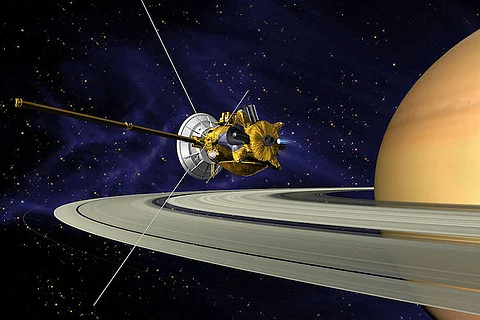

A thrilling epoch in the exploration of our solar system came to a close on Friday when NASA's Cassini spacecraft made a fateful plunge into the atmosphere of Saturn, ending its 13-year tour of the ringed planet.
Cassini's plunge brings to a close a series of 22 weekly "Grand Finale" dives between Saturn and its rings, a feat never before attempted by any spacecraft.
"This is the final chapter of an amazing mission, but it's also a new beginning," said Thomas Zurbuchen, Associate Administrator for NASA's Science Mission Directorate at NASA Headquarters in Washington.
As expected, Cassini entered Saturn's atmosphere with its thrusters firing to maintain stability, as it sent back a unique final set of science observations, NASA said.
Loss of contact with the Cassini spacecraft occurred at 7.55 a.m. EDT (5.25 pm Friday India time), with the signal received by NASA's Deep Space Network antenna complex in Canberra, Australia.
"It's a bittersweet, but fond, farewell to a mission that leaves behind an incredible wealth of discoveries that have changed our view of Saturn and our solar system, and will continue to shape future missions and research," said Michael Watkins, Director of NASA's Jet Propulsion Laboratory (JPL) in Pasadena, California.
During its historic exploration, Cassini discovered that Saturn's planet-sized moon Titan has three large seas, all located close to the moon's north pole, surrounded by numerous smaller lakes in the northern hemisphere.
For decades, scientists did not know why Saturn's icy moon Enceladus was the brightest world in the solar system, or how it related to Saturn's E ring. Cassini found that both the fresh coating on its surface, and icy material in the E ring originate from vents connected to a global subsurface saltwater ocean that might host hydrothermal vents.
With its global ocean, unique chemistry and internal heat, Enceladus has become a promising lead in our search for worlds where life could exist.
"Cassini's discovery of ocean worlds at Titan and Enceladus changed everything, shaking our views to the core about surprising places to search for potential life beyond Earth," Zurbuchen added.
As planned, data from eight of Cassini's science instruments was beamed back to Earth.
Mission scientists will examine the spacecraft's final observations in the coming weeks for new insights about Saturn, including hints about the planet's formation and evolution, and processes occurring in its atmosphere, NASA said.
"Things never will be quite the same for those of us on the Cassini team now that the spacecraft is no longer flying," Linda Spilker, Cassini project scientist at JPL, said.
"But, we take comfort knowing that every time we look up at Saturn in the night sky, part of Cassini will be there, too," Spilker added.
Launched in 1997, the $3.26-billion Cassini-Huygens mission had been touring the Saturn system since arriving there in 2004.
NASA extended its mission twice -- first for two years, and then for seven more.
The second mission extension provided dozens of flybys of the planet's icy moons, using the spacecraft's remaining rocket propellant along the way.
Cassini finished its tour of the Saturn system with its Grand Finale, capped by Friday's intentional plunge into the planet to ensure Saturn's moons -- particularly Enceladus, with its subsurface ocean and signs of hydrothermal activity -- remain pristine for future exploration.